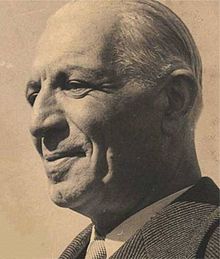Morteza Gholi Bayat
Morteza Gholi Bayat ( Persian مرتضیقلی بیات, also Mortazā Qolī Bayāt Sahām al-Soltān , * 1882 in Arak ; † 1955 ) was Prime Minister of Iran.
Life
Morteza Gholi Bayat was born in Arak in 1882 as the son of wealthy landowners. Morteza's father, Haj Abbas Qoli-Khan Saham al-Molk Araki, fought for the Constitutional Revolution of Iran as the leader of the Bayat tribe and founder of the Democratic Party in Arak .
Morteza Gholi Bayat was a member of the Iranian parliament for over ten years. In June 1921, Bayat was one of the signatories of the "Document of Truth," which had appeared in a Tehran daily newspaper, which called for the annulment of the Anglo-Iranian treaty of 1919 and the condemnation of Seyyed Zia al Din Tabatabai . Tabatabai had overthrown Prime Minister Fathollah Akbar Sepahdar in a coup on February 21, 1921 and then assumed the office of Prime Minister for 100 days. During the reign of Prime Minister Reza Khan, later Reza Shah Pahlavi , Bayat was Vice-President of the Iranian Parliament.
In 1925, Bayat became finance minister in the first cabinet of Prime Minister Mohammad Ali Foroughi under Reza Shah. He took this office a second time in 1935 in the cabinet of Prime Minister Ali Soheili .
Morteza Gholi Bayat became Prime Minister on November 25, 1944 during the British-Soviet occupation of Iran as part of the Anglo-Soviet invasion . During this time General Charles de Gaulle paid a visit to Tehran. De Gaulle traveled to Moscow on November 27, 1944 to coordinate with Stalin. On the return journey, de Gaulle stopped in Tehran on December 13, 1944. He thanked Shah Mohammad Reza Pahlavi for the official recognition of the Provisional Government he led by Iran on July 10, 1944 . The recognition took place before the liberation of Paris, which did not take place until August 5, 1944. Immediately after Iran's recognition, de Gaulle sent an ambassador to Tehran to resume the previously broken ties between the two countries. Another important decision was made during Prime Minister Bayat's reign when Iran declared war on Japan.
Prime Minister Morteza Gholi Bayat's term of office only lasted a few months. Bayat resigned on May 2, 1945. His successor in the office of Prime Minister was Ali Soheili .
In 1953, Bayat became head of the National Iranian Oil Company (NIOC). He held this post until 1955
Morteza Gholi Bayat was buried in Najaf after his death .
literature
- Avsati, Alireza, Iran in the last 3 Centuries , Tehran, 2003. Vol. 1 ISBN 964-93406-6-1 , Vol. 2 ISBN 964-93406-5-3
Individual evidence
- ^ Cyrus Ghani: Iran and the Rise of Reza Shah. IBTauris, 2000, p. 312.
- ^ Cyrus Ghani: Iran and the Rise of Reza Shah. IBTauris, 2000, p. 238.
- ^ Cyrus Ghani: Iran and the Rise of Reza Shah. IBTauris, 2000, p. 311.
- ^ Catherine Legrand, Jacques Legrand: the Shah of Iran. 1998, p. 46f.
| personal data | |
|---|---|
| SURNAME | Bayat, Morteza Gholi |
| ALTERNATIVE NAMES | Bayāt, Mortezā Qoli |
| BRIEF DESCRIPTION | Iranian politician and Prime Minister of Iran |
| DATE OF BIRTH | 1882 |
| PLACE OF BIRTH | Arak |
| DATE OF DEATH | 1955 |
